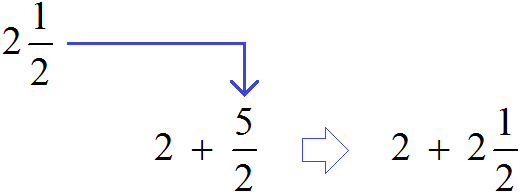You may encounter problems in which you need to add a whole number and a fraction. For example, add a number 2 and a fraction![]() . To solve this example, you need to represent the number 2 as a fraction
. To solve this example, you need to represent the number 2 as a fraction ![]() . Then add fractions with different denominators:
. Then add fractions with different denominators:

Now look carefully at this example. Let's look at the beginning and the end of it. Its beginning looks like this: ![]() , and the end is this:
, and the end is this: ![]() . The difference is that in the first case the number 2 and the fraction
. The difference is that in the first case the number 2 and the fraction ![]() are joined by an addition sign, and in the second case they are written together. In fact, this is the same thing. The point is that
are joined by an addition sign, and in the second case they are written together. In fact, this is the same thing. The point is that ![]() is a convolute form of a mixed number, and
is a convolute form of a mixed number, and ![]() is an expanded form.
is an expanded form.
When we have a mixed number of the form ![]() in front of us, we must realize that the addition sign is omitted.
in front of us, we must realize that the addition sign is omitted.
What conclusion can be drawn? If you need to add a number to a proper fraction, you can omit the plus sign and write the whole number and fraction together.
So the value of the expression ![]() is
is ![]()
![]()
If you add half a pizza to two whole pizzas, you get two whole pizzas and half a pizza:

Example 2. Find the value of the expression ![]()
Let's represent the number 3 as a fraction of ![]() . Then add fractions with different denominators:
. Then add fractions with different denominators:

This is the first way. The second way is much easier. You can put an equal sign and write the whole part and the fractional part together. That is, omit the addition sign:
![]()
Example 3. Find the value of the expression ![]()
You can write the number 2 and the fraction ![]() together, but that answer will not be final because you can separate the whole part in the fraction
together, but that answer will not be final because you can separate the whole part in the fraction ![]() .
.
Therefore, in this example, you must first isolate the whole part in the fraction ![]() . Five second fractions are two integers and one second:
. Five second fractions are two integers and one second:
![]()
Now, in the main expression ![]() we write the mixed number
we write the mixed number ![]() instead of the fraction
instead of the fraction ![]()

We have a new expression ![]() . In this expression, write the mixed number
. In this expression, write the mixed number ![]() in expanded form:
in expanded form:
![]()
Apply the combinative law of addition. If we add two twos, we get 4:
![]()
Now let's roll up the resulting mixed number:
![]()
This is the final answer. The detailed solution of this example can be written as follows:
![]()
2. If you find an error or inaccuracy, please describe it.
3. Positive feedback is welcome.